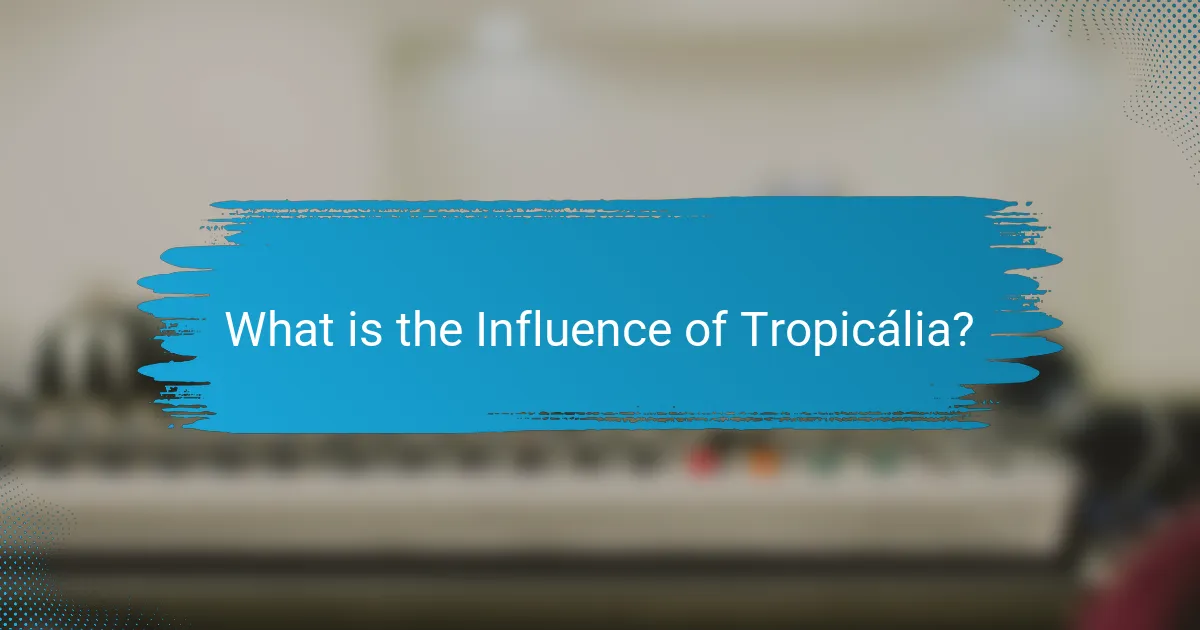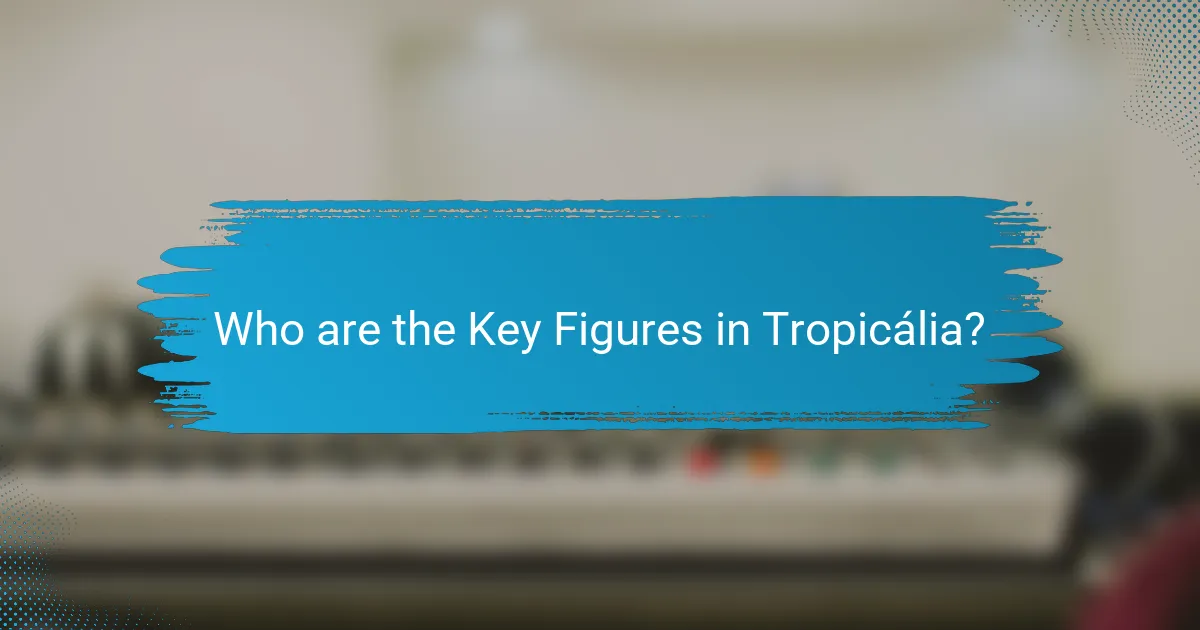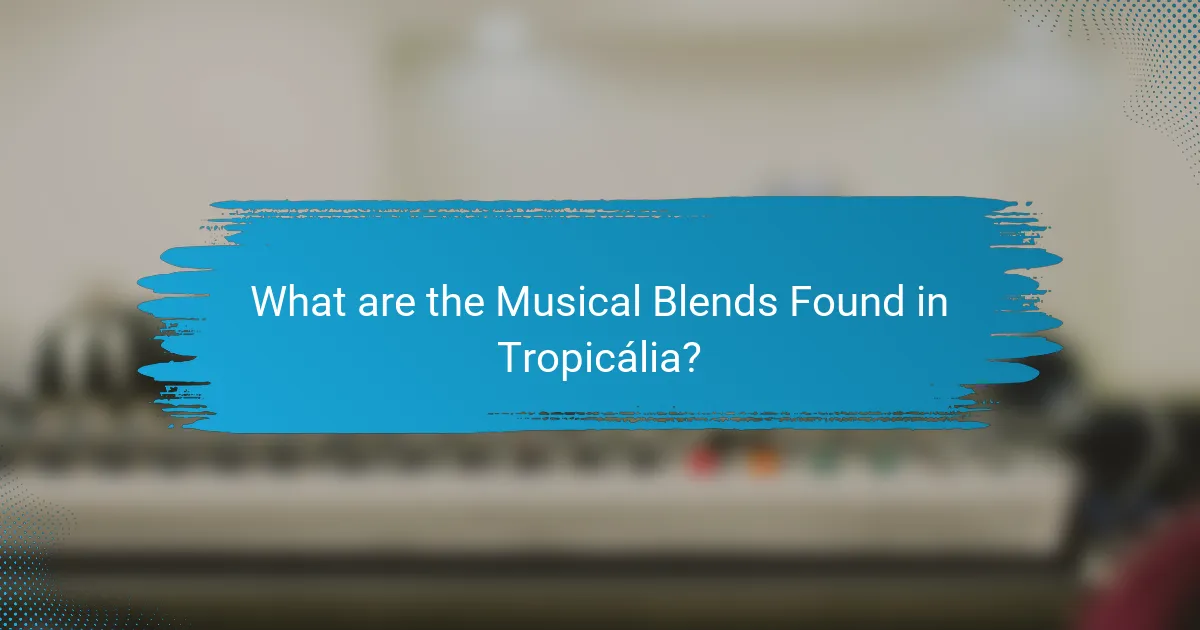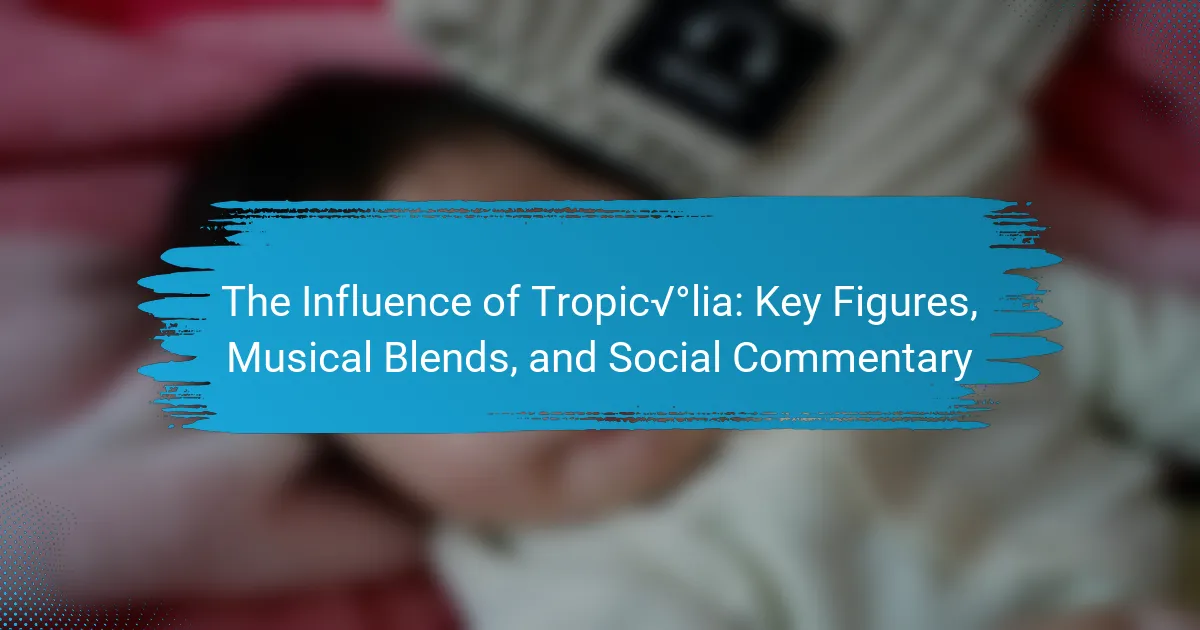Tropicália is a significant cultural movement that emerged in Brazil during the late 1960s, characterized by its fusion of traditional Brazilian music with international genres such as rock and jazz. Key figures in this movement include musicians Caetano Veloso and Gilberto Gil, along with the band Os Mutantes. Tropicália not only transformed the musical landscape but also addressed social issues and political repression through its innovative sound and visual arts. The movement’s legacy continues to influence contemporary Brazilian artists, symbolizing cultural resistance and creativity. This article explores the impact of Tropicália, highlighting its key figures, musical blends, and social commentary.

What is the Influence of Tropicália?
Tropicália significantly influenced Brazilian music and culture. It emerged in the late 1960s as a response to political repression. The movement blended traditional Brazilian music with international styles like rock and jazz. Key figures included Caetano Veloso and Gilberto Gil, who challenged societal norms. Tropicália also incorporated visual arts and theater, creating a holistic cultural movement. Its themes addressed social issues and promoted political awareness. The movement left a lasting legacy on future generations of musicians and artists in Brazil. Tropicália remains a symbol of cultural resistance and innovation.
How did Tropicália emerge as a cultural movement?
Tropicália emerged as a cultural movement in Brazil during the late 1960s. It was a response to political repression under the military dictatorship. Artists sought to blend traditional Brazilian music with international influences, particularly rock and pop. Key figures included Caetano Veloso and Gilberto Gil, who challenged cultural norms. The movement incorporated visual arts, theater, and literature. Tropicália aimed to provoke thought and inspire social change. Its manifesto emphasized the importance of cultural diversity and innovation. The movement significantly influenced Brazilian music and arts, leaving a lasting legacy.
What historical context influenced the rise of Tropicália?
The rise of Tropicália was influenced by Brazil’s political and social upheaval during the late 1960s. The military coup in 1964 led to a repressive regime that stifled artistic expression. This environment prompted artists to seek new forms of cultural identity and political commentary. Tropicália emerged as a response to both local and global influences, mixing Brazilian music with international genres like rock and pop. Key figures like Caetano Veloso and Gilberto Gil were instrumental in this movement. They incorporated diverse musical styles and critiqued the socio-political landscape. The movement also reflected a desire for cultural freedom amidst censorship. Tropicália ultimately became a symbol of resistance and innovation in Brazilian art.
Who were the key figures behind the Tropicália movement?
The key figures behind the Tropicália movement include Caetano Veloso, Gilberto Gil, and Os Mutantes. Caetano Veloso was a leading musician and songwriter who played a pivotal role in defining the movement’s sound. Gilberto Gil, also a prominent musician, contributed to the blend of traditional Brazilian music with international influences. Os Mutantes was a groundbreaking band known for their innovative approach to music and performance. These figures collectively challenged cultural norms and political repression in Brazil during the late 1960s. Their work combined music, art, and social commentary, making a lasting impact on Brazilian culture.
What are the core characteristics of Tropicália music?
Tropicália music is characterized by its eclectic fusion of various musical styles. It blends traditional Brazilian genres, such as samba and bossa nova, with international influences like rock and pop. This genre emerged in the late 1960s during Brazil’s military dictatorship. The music often incorporates experimental sounds and unconventional instrumentation. Tropicália lyrics are known for their poetic and sometimes politically charged content. The genre also embraces a vibrant visual aesthetic, influencing art and fashion. Key figures in Tropicália include Caetano Veloso and Gilberto Gil, who played significant roles in its development. The movement aimed to challenge cultural norms and promote social change through artistic expression.
How does Tropicália blend different musical styles?
Tropicália blends different musical styles by integrating elements of Brazilian popular music with international genres. This movement incorporates bossa nova, samba, rock, and psychedelic music. Artists like Caetano Veloso and Gilberto Gil were pivotal in this fusion. They combined traditional Brazilian rhythms with electric instruments and avant-garde influences. Tropicália also embraced diverse cultural references, including cinema and visual arts. This eclectic approach reflected Brazil’s social and political landscape in the late 1960s. The result was a vibrant and innovative sound that challenged musical norms. Tropicália’s influence continues to resonate in contemporary music.
What instruments and sounds are commonly associated with Tropicália?
Tropicália is commonly associated with a diverse range of instruments and sounds. Key instruments include electric guitars, keyboards, and traditional Brazilian percussion. The electric guitar provided a rock influence, while keyboards added a modern touch. Percussion instruments like berimbau and pandeiro contributed to the Brazilian sound. Additionally, the use of orchestral strings is notable in Tropicália music. The blending of these elements created a unique sound that defined the movement. Tropicália artists often experimented with musical styles, incorporating samba, bossa nova, and rock. This fusion reflects the cultural diversity of Brazil during the late 1960s.
What social commentary is present in Tropicália?
Tropicália presents a critique of Brazilian society and politics during the military dictatorship. The movement combines various artistic expressions to challenge cultural norms. It highlights the clash between traditional Brazilian values and modern influences. Tropicália also addresses issues of identity and nationalism. The use of irony and satire serves to question authority and conformity. Artists like Caetano Veloso and Gilberto Gil embodied these themes in their music. Their works reflect a desire for social change and political freedom. The movement ultimately represents a broader call for cultural and artistic liberation in Brazil.
How do Tropicália artists address political issues through their music?
Tropicália artists address political issues through their music by blending diverse musical styles with poignant lyrics. They use irony and satire to critique the Brazilian military dictatorship. Songs often incorporate elements of traditional Brazilian music with rock and avant-garde influences. This fusion creates a unique sound that captures the discontent of the era.
For instance, Caetano Veloso and Gilberto Gil’s lyrics challenge social norms and government repression. Their work reflects the struggles of the Brazilian populace during the late 1960s. The Tropicália movement also embraces visual art and performance, enhancing its political messages. This multidisciplinary approach amplifies the impact of their social commentary.
Overall, Tropicália artists effectively use music as a form of resistance and expression against political oppression.
What themes are prevalent in the lyrics of Tropicália songs?
Tropicália songs often explore themes of cultural identity and social critique. These lyrics reflect Brazil’s diverse cultural landscape. They incorporate elements of traditional Brazilian music and international influences. The songs frequently address political issues and social injustices. They also celebrate the fusion of different musical styles. Tropicália artists challenge societal norms and conventions. The lyrics often convey a sense of irony and playfulness. This thematic richness contributes to the movement’s lasting impact on Brazilian music and culture.

Who are the Key Figures in Tropicália?
The key figures in Tropicália include Caetano Veloso, Gilberto Gil, and Os Mutantes. Caetano Veloso is a prominent musician and songwriter known for his innovative blending of genres. Gilberto Gil is another influential musician who contributed to the movement with his unique sound. Os Mutantes, a groundbreaking band, played a crucial role in shaping the Tropicália sound. Other notable figures include Gal Costa and Tom Zé, who also made significant contributions to the movement. Tropicália emerged in the late 1960s in Brazil as a response to political repression. The movement combined traditional Brazilian music with international influences, creating a vibrant cultural revolution.
What roles did Caetano Veloso and Gilberto Gil play in Tropicália?
Caetano Veloso and Gilberto Gil were central figures in the Tropicália movement. They were both influential musicians and cultural icons in Brazil during the late 1960s. Veloso’s music blended traditional Brazilian styles with international influences. His song “Tropicália” exemplified this fusion. Gil’s work also combined various musical genres, emphasizing Brazilian rhythms and rock. He contributed to the movement’s avant-garde aesthetic. Together, they challenged societal norms and political repression through their art. Their performances were marked by theatricality and bold statements. Veloso and Gil’s roles helped define Tropicália as a revolutionary cultural movement in Brazil.
How did their backgrounds influence their contributions to the movement?
The backgrounds of key figures in the Tropicália movement significantly influenced their contributions. Many were exposed to a mix of traditional Brazilian music and international influences. This diverse musical upbringing allowed them to blend genres creatively. For instance, Gilberto Gil and Caetano Veloso were influenced by both Brazilian folk and rock music. Their experiences with political repression shaped their lyrical content and social commentary. Growing up in a politically charged environment, they addressed issues of identity and resistance. The cultural richness of Bahia, their home state, infused their work with local color and authenticity. Their backgrounds thus provided a unique lens through which they interpreted and critiqued Brazilian society.
What notable works did they produce during the Tropicália era?
Notable works produced during the Tropicália era include “Tropicália: Ou Panis et Circenses” by Caetano Veloso and Gilberto Gil. This album, released in 1968, is a cornerstone of the movement. It features a blend of traditional Brazilian music with rock and avant-garde influences. Another significant work is “Construção” by Chico Buarque. Released in 1975, it reflects social issues and innovative musical structures. “Águas de Março” by Antonio Carlos Jobim also emerged during this time, showcasing the fusion of bossa nova and other genres. These works exemplify the artistic experimentation and political commentary characteristic of Tropicália.
Who are other significant artists associated with Tropicália?
Significant artists associated with Tropicália include Caetano Veloso, Gilberto Gil, and Gal Costa. Caetano Veloso was a key figure in the movement, blending traditional Brazilian music with international influences. Gilberto Gil, another prominent artist, contributed to the fusion of rock and Brazilian styles. Gal Costa was known for her powerful voice and innovative interpretations of Tropicália songs. Other notable artists include Tom Zé, who pushed the boundaries of Brazilian music, and Os Mutantes, a band that incorporated psychedelic elements. These artists collectively shaped the Tropicália movement, which emerged in the late 1960s in Brazil. Their work challenged social norms and addressed political issues of the time.
What contributions did Gal Costa and Os Mutantes make to the movement?
Gal Costa and Os Mutantes significantly contributed to the Tropicália movement. Gal Costa introduced innovative vocal styles and blended traditional Brazilian music with international rock influences. Her album “Gal Costa,” released in 1969, showcased this fusion and challenged musical norms. Os Mutantes, formed in 1966, were pioneers of psychedelic rock in Brazil. They incorporated experimental sounds and surreal lyrics into their music. Their self-titled debut album, released in 1968, exemplified this creativity. Both Gal Costa and Os Mutantes pushed boundaries and promoted cultural dialogue during a politically turbulent time in Brazil. Their work remains influential in shaping Brazilian music and identity.
How did these artists’ styles differ from one another?
The artists’ styles in Tropicália differed primarily in their musical influences and thematic focus. Caetano Veloso blended traditional Brazilian music with rock and pop elements. Gilberto Gil incorporated reggae and African rhythms into his work. Gal Costa showcased a more avant-garde approach, emphasizing experimental sounds and vocal techniques. Maria Bethânia focused on poetic lyrics and emotive performances. Each artist’s unique combination of genres and personal expression created distinct soundscapes. Their varied approaches contributed to the rich tapestry of the Tropicália movement.

What are the Musical Blends Found in Tropicália?
Tropicália features a blend of various musical styles, including bossa nova, rock, samba, and MPB (Música Popular Brasileira). These genres were combined to create a unique sound that reflected Brazil’s cultural diversity. Bossa nova contributed its smooth melodies and rhythms. Rock introduced electric instruments and a more rebellious spirit. Samba added traditional Brazilian rhythms and dance elements. MPB provided a platform for lyrical innovation and social commentary. This fusion was a response to Brazil’s political climate in the 1960s. Artists like Caetano Veloso and Gilberto Gil were pivotal in this movement, embracing both local and global influences. Their work exemplified the creative potential of blending different musical traditions.
How does Tropicália incorporate traditional Brazilian music?
Tropicália incorporates traditional Brazilian music by blending it with international styles. This movement emerged in the late 1960s, combining elements of samba, bossa nova, and folk music. Artists like Caetano Veloso and Gilberto Gil infused these traditional sounds with rock, jazz, and avant-garde influences. They often used traditional instruments, such as the berimbau and cuíca, alongside electric guitars and synthesizers. The lyrics frequently referenced Brazilian culture and social issues, creating a rich tapestry of sound. Tropicália challenged conventional music norms while celebrating Brazil’s diverse musical heritage. This fusion attracted both national and international attention, reshaping Brazil’s cultural landscape. The movement remains influential in contemporary Brazilian music today.
What specific genres are fused within Tropicália?
Tropicália fuses various genres including samba, bossa nova, rock, and MPB (Música Popular Brasileira). This movement emerged in Brazil during the late 1960s. It combined traditional Brazilian music with international influences. The fusion created a unique sound that challenged cultural norms. Artists like Caetano Veloso and Gilberto Gil were pivotal in this genre blending. Their works incorporated elements of psychedelia and avant-garde music. This genre fusion reflected Brazil’s socio-political landscape at the time. Tropicália remains influential in contemporary Brazilian music.
How does the blending of genres enhance the overall sound?
Blending genres enhances the overall sound by creating a richer, more diverse musical experience. This fusion allows artists to incorporate various elements, rhythms, and melodies from different styles. For example, Tropicália mixed Brazilian music with rock, jazz, and avant-garde influences. This genre blending results in innovative sounds that challenge traditional boundaries. Furthermore, it encourages creativity and experimentation among musicians. The combination of genres can also attract a broader audience, as it appeals to fans of multiple styles. Ultimately, blending genres enriches the musical landscape and fosters cultural exchange.
What international influences can be identified in Tropicália music?
Tropicália music incorporates various international influences, notably from rock, bossa nova, and traditional Brazilian music. The genre emerged in the late 1960s during a time of cultural exchange. Artists like Caetano Veloso and Gilberto Gil fused American rock with Brazilian rhythms. The Beatles and Bob Dylan were significant inspirations for Tropicália musicians. The use of electric instruments and experimental sounds reflects global trends in music. Additionally, Tropicália drew from the avant-garde movements in Europe and the United States. This blend created a unique sound that challenged social norms and political structures in Brazil. The combination of these influences contributed to the genre’s innovative and revolutionary character.
How did rock and pop music shape the Tropicália sound?
Rock and pop music significantly influenced the Tropicália sound by introducing new musical styles and cultural references. Tropicália emerged in the late 1960s in Brazil. It blended traditional Brazilian music with international rock and pop elements. Artists like Caetano Veloso and Gilberto Gil incorporated electric guitars and experimental sounds. This fusion created a vibrant and innovative musical landscape. The movement also reflected social and political changes in Brazil. The use of English lyrics and global pop aesthetics connected Brazilian music to broader cultural movements. Tropicália artists sought to challenge societal norms through their music. Their work showcased the power of blending diverse musical influences to create something unique.
What global musical trends were embraced by Tropicália artists?
Tropicália artists embraced various global musical trends, including rock, bossa nova, and psychedelic music. They incorporated elements of American rock and roll, influenced by bands like The Beatles. Additionally, Tropicália artists blended traditional Brazilian styles with international genres. This fusion created a unique sound that challenged cultural norms. The movement also reflected social and political issues of the time. Artists like Caetano Veloso and Gilberto Gil were key figures in this movement. Their work showcased the influence of global music while celebrating Brazilian identity. Tropicália was a significant cultural response to the military dictatorship in Brazil during the 1960s.
What practical insights can be drawn from the Influence of Tropicália?
The Influence of Tropicália offers insights into cultural fusion and social activism. It highlights the blending of diverse musical styles, such as samba, bossa nova, and rock. This fusion reflects a broader acceptance of varied cultural influences. Tropicália also emphasizes the importance of artistic expression in political discourse. Artists like Caetano Veloso and Gilberto Gil used music to challenge authoritarian regimes in Brazil. This approach demonstrates how art can serve as a tool for social change. The movement’s legacy encourages contemporary artists to explore identity and resistance through their work. Tropicália’s impact continues to inspire new generations to engage with socio-political issues creatively.
How can contemporary musicians learn from Tropicália’s approach to blending genres?
Contemporary musicians can learn from Tropicália’s approach to blending genres by embracing eclecticism. Tropicália combined Brazilian music with rock, jazz, and avant-garde influences. This fusion created a unique sound that resonated with diverse audiences. Musicians can experiment with various genres to develop their distinct style. The movement emphasized cultural identity and social commentary, encouraging artists to reflect societal issues through their music. Tropicália’s innovative spirit shows the value of collaboration across musical boundaries. By adopting this mindset, contemporary musicians can foster creativity and expand their artistic horizons.
What lessons about social commentary in music can be applied today?
Social commentary in music today can draw lessons from historical movements like Tropicália. Artists can use music as a platform for political expression and social critique. Tropicália blended diverse musical styles to challenge cultural norms. This approach shows the importance of innovation in conveying messages. Collaborating across genres can amplify the impact of social commentary. Engaging audiences emotionally can foster deeper connections to social issues. The use of visual art and performance alongside music enhances the message’s reach. Tropicália’s legacy reminds artists to remain relevant and responsive to societal changes.
The main entity of the article is Tropicália, a cultural movement that emerged in Brazil during the late 1960s, significantly influencing music and arts. The article examines the key figures of the movement, such as Caetano Veloso and Gilberto Gil, and their role in blending traditional Brazilian music with international genres like rock and jazz. It also explores the social commentary present in Tropicália’s lyrics, addressing political repression and cultural identity. Additionally, the article discusses the unique musical blends and instruments associated with Tropicália, highlighting its lasting impact on future generations of artists and musicians in Brazil.
